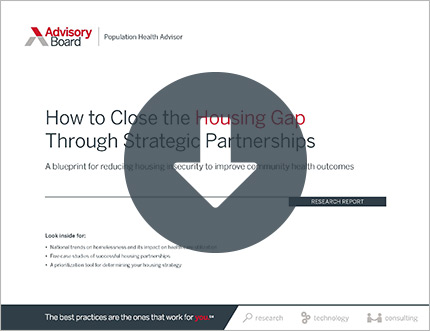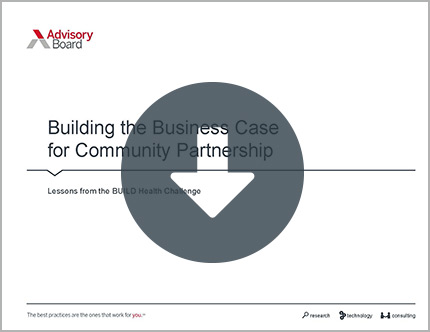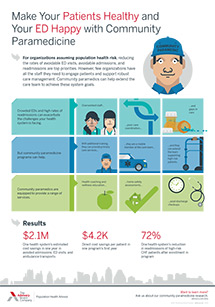Auto logout in seconds.
Continue LogoutAfrican Americans are disproportionately likely to suffer from health problems and to die young—and The Atlantic's Olga Khazan reports that a major cause is "profoundly unhealthy neighborhoods" that expose many African Americans to wide-ranging health risks, from lead paint to acute, never-ending stress.
To reduce behavioral health disparities, use these 3 PCP-centered strategies
Background
In recent decades, racial disparities in early deaths have narrowed, with the life expectancy among blacks rising to within three years of the life expectancy among whites. However, African Americans continue to face a greater risk of dying at virtually every point in life, Khazan reports.
With rare exceptions, such as nondiabetic kidney disease, scientists haven't found a link between genetics and racial health disparities. In fact, many scientists have come to believe that many health disparities are due to environmental and social factors that disproportionately affect African Americans, Khazan reports.
According to Khazan, the health disparities African American face tell "a bigger story, of how African Americans became stuck in profoundly unhealthy neighborhoods, and of how the legacy of racism can literally take years off their lives." Health disparities are most pronounced in segregated cities—such as Baltimore, Chicago, and Philadelphia—where "far from being a relic of the past, America's racist and segregationist history continues to harm black people in the most intimate of ways—seeping into their lungs, their blood, even their DNA," Khazan reports.
For nearly a year, Khazan explored the health disparities that African Americans experience in Baltimore—one of the United States' most racially segregated cities, where the gap in life expectancy between African Americans and whites is as wide as two decades. The Atlantic focused on Kiarra Boulware, a 27-year-old woman raised in Baltimore who is 5-foot-2 and over 200 pounds has several obesity-related health conditions, including diabetes, sleep apnea, and menstrual dysregulation.
Boulware's life in Baltimore
Boulware grew up in Baltimore during the 1990s, when the city grappled—as it does today—with drugs, violence, and poverty. According to Khazan, Baltimore in 1996 had the highest rate of drug-related emergency department visits in the United States and it had one of the highest homicide rates in the nation. Boulware, like many in her neighborhood, lived in a house that exposed her to high concentrations of lead from old paint—which is linked to several health problems.
Boulware's early life, according to Khazan, was filled with "adverse childhood experiences" (ACES): stressful events early in a person's life that research has determined can lead to health problems in adulthood. Research has shown six or more ACES can lower a person's life expectancy by as many as 20 years—and Boulware had at least six ACES. For example, Boulware's father had been incarcerated, which meant her parents weren't together, and guns and drugs were common in her neighborhood.
Boulware's experience wasn't atypical. According to Khazan, nearly a third of children in Baltimore have two or more ACES. Children who have four or more ACES are seven times more likely to be alcoholics than children with no ACES and they are twice as likely to have heart disease, Khazan reports.
Other traumatic experiences Boulware experienced included hearing her stepbrother get shot and killed and giving birth at 13 to an infant who died unexpectedly within a year. The death of her child, Khazan writes, left Boulware "so traumatized that she ended up spending more than a month in a psychiatric hospital" and "when she came home, her boyfriend physically and sexually abused her."
Boulware, like many who are abused, found comfort in eating food, Khazan reports, citing a 2013 study involving thousands of women that showed childhood victims of severe sexual and physical abuse had an increased risk of food addiction. Boulware said she ate "everything [and] anything," but "mostly bad foods, junk food, pizza," and as a result, her weight increased.
After graduating high school, Boulware attended local community colleges and accumulated $30,000 in student loans with only a year's worth of college credits. Boulware decided to place college on hold and secured a job at Kmart and as a home health aide. Around that time, she started drinking vodka and doing ecstasy—which led to a breakdown and her first attempt at recovery at Maryland Community Health Initiatives in Penn North. In 2017, she made her latest and third attempt at recovery, working with doctors to regain control of her eating habits, substance misuse, and her overall health.
Social, environment factors at play
Boulware lives in Sandtown, a neighborhood in Baltimore where Khazan reports 97% of residents are black and 50% of families live in poverty. While the neighborhood's homicide and drug overdose death rates are higher than the rest of the city, the leading causes of death among residents are heart disease and cancer.
According to Khazan, several factors associated with living in low-income areas affect a person's health, such as an increased likelihood of exposure to mouse infestation or lead paint. Mice can trigger asthma in children, which increases the risk of obesity and poorer health in adulthood. At age 6, Khazan reports Boulware's test results showed her blood lead level "was more than six times the level CDC considers elevated—an amount that can irreversibly lower IQ and reduce attention span," Khazan writes.
Neighborhoods with predominantly black residents also "tend to become what researchers call 'food swamps,' or areas where fast-food joints outnumber healthier options," Khazan reports.
Stress is another health risk for people who live in low-income areas. "Living in a dangerous neighborhood like Sandtown requires a vigilance that can flood the body with adrenaline and cortisol," Khazan writes. When those hormones are triggered over prolonged periods, "they can raise the risk of heart disease and compromise the body’s immune system," Khazan writes.
In addition, several studies have shown increased exposure to stressful experiences—such as those Boulware experienced—is associated with shortened telomeres, which are protective caps at the end of chromosomes in DNA. Some researchers believe that stress can shrink telomeres so severely that cells die, accelerating biological aging and the onset of disease.
And researchers have found that those biological changes can affect even African Americans who live in higher-income areas, Khazan reports. Those findings have led some researchers to believe prejudice and racism may play a key role in African Americans' stress—and may partly explain why African American women are 50% more likely to give birth prematurely than white women, Khazan reports.
The United States' history with racism also explains why so many African Americans "became trapped" in some of Baltimore's poorest and least healthy neighborhoods, Khazan reports. "It began with outright bans on their presence in certain neighborhoods in the early 1900s and continued through the 2000s, when policymakers, lenders, and fellow citizens employed subtler forms of discrimination," such as landlords not properly maintaining homes, as well as house flippers purchasing and reselling homes in predominantly black neighborhoods using falsified documents that result in foreclosures.
According to Khazan, the fast food industry in the 1990s received federal incentives to open restaurants in urban locations and adjusted their marketing strategies to "entice black customers." Khazan reports that the "marketing and franchising onslaught" significantly changed the way African Americans consumed food (Khazan, The Atlantic, July/August 2018).
How to address health inequity in your community
With the shift in health care to focus on optimizing the health of individuals and communities, health care organizations are creating new strategies to address health care disparities in access and patient outcomes.
Advisory Board has created the Health Disparities Initiative, which provides actionable resources on a series of strategic imperatives and special topics to achieve equity of care. Interested in seeing research or resources that address your biggest health equity problems?
Download our resource, "Building Community Partnerships to Reduce Disparities," which includes studies featuring providers who have successfully partnered with community organizations to address health disparities and social determinants of health. You'll also find tools that can guide your organization’s community partnership strategy.
Don't miss out on the latest Advisory Board insights
Create your free account to access 1 resource, including the latest research and webinars.
Want access without creating an account?
You have 1 free members-only resource remaining this month.
1 free members-only resources remaining
1 free members-only resources remaining
You've reached your limit of free insights
Become a member to access all of Advisory Board's resources, events, and experts
Never miss out on the latest innovative health care content tailored to you.
Benefits include:
You've reached your limit of free insights
Become a member to access all of Advisory Board's resources, events, and experts
Never miss out on the latest innovative health care content tailored to you.
Benefits include:
This content is available through your Curated Research partnership with Advisory Board. Click on ‘view this resource’ to read the full piece
Email ask@advisory.com to learn more
Click on ‘Become a Member’ to learn about the benefits of a Full-Access partnership with Advisory Board
Never miss out on the latest innovative health care content tailored to you.
Benefits Include:
This is for members only. Learn more.
Click on ‘Become a Member’ to learn about the benefits of a Full-Access partnership with Advisory Board
Never miss out on the latest innovative health care content tailored to you.



